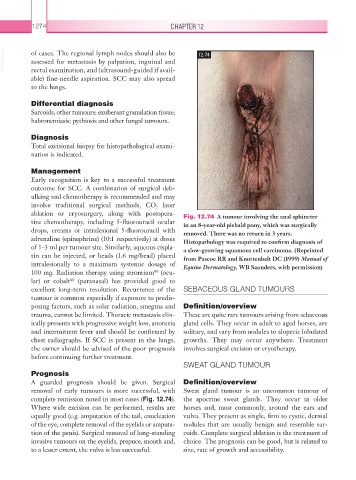Page 1299 - Equine Clinical Medicine, Surgery and Reproduction, 2nd Edition
P. 1299
1274 CHAPTER 12
VetBooks.ir of cases. The regional lymph nodes should also be 12.74
assessed for metastasis by palpation, inguinal and
rectal examination, and (ultrasound-guided if avail-
able) fine-needle aspiration. SCC may also spread
to the lungs.
Differential diagnosis
Sarcoids; other tumours; exuberant granulation tissue;
habronemiasis; pythiosis and other fungal tumours.
Diagnosis
Total excisional biopsy for histopathological exami-
nation is indicated.
Management
Early recognition is key to a successful treatment
outcome for SCC. A combination of surgical deb-
ulking and chemotherapy is recommended and may
involve traditional surgical methods, CO laser
2
ablation or cryosurgery, along with postopera- Fig. 12.74 A tumour involving the anal sphincter
tive chemotherapy, including 5-fluorouracil ocular in an 8-year-old piebald pony, which was surgically
drops, creams or intralesional 5-fluorouracil with removed. There was no return in 3 years.
adrenaline (epinephrine) (10:1 respectively) at doses Histopathology was required to confirm diagnosis of
of 1–3 ml per tumour site. Similarly, aqueous cispla- a slow-growing squamous cell carcinoma. (Reprinted
tin can be injected, or beads (1.6 mg/bead) placed from Pascoe RR and Knottenbelt DC (1999) Manual of
intralesionally to a maximum systemic dosage of Equine Dermatology, WB Saunders, with permission)
100 mg. Radiation therapy using strontium (ocu-
90
lar) or cobalt (paranasal) has provided good to
60
excellent long-term resolution. Recurrence of the SEBACEOUS GLAND TUMOURS
tumour is common especially if exposure to predis-
posing factors, such as solar radiation, smegma and Definition/overview
trauma, cannot be limited. Thoracic metastasis clin- These are quite rare tumours arising from sebaceous
ically presents with progressive weight loss, anorexia gland cells. They occur in adult to aged horses, are
and intermittent fever and should be confirmed by solitary, and vary from nodules to alopecic lobulated
chest radiographs. If SCC is present in the lungs, growths. They may occur anywhere. Treatment
the owner should be advised of the poor prognosis involves surgical excision or cryotherapy.
before continuing further treatment.
SWEAT GLAND TUMOUR
Prognosis
A guarded prognosis should be given. Surgical Definition/overview
removal of early tumours is more successful, with Sweat gland tumour is an uncommon tumour of
complete remission noted in most cases (Fig. 12.74). the apocrine sweat glands. They occur in older
Where wide excision can be performed, results are horses and, most commonly, around the ears and
equally good (e.g. amputation of the tail, enucleation vulva. They present as single, firm to cystic, dermal
of the eye, complete removal of the eyelids or amputa- nodules that are usually benign and resemble sar-
tion of the penis). Surgical removal of long-standing coids. Complete surgical ablation is the treatment of
invasive tumours on the eyelids, prepuce, mouth and, choice. The prognosis can be good, but is related to
to a lesser extent, the vulva is less successful. size, rate of growth and accessibility.

